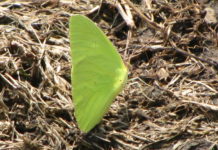Photo credit: DiasporaEngager (www.DiasporaEngager.com).
“ILCYM helps us understand the risk that pests pose in the present and future under climate change, which helps us prepare for those threats,” explains Santiago Reyes, an official at the Ecuadorian phytosanitary and zoosanitary regulation and control agency, Agrocalidad.
Reyes cites the example of the potato psyllid, a small insect that causes massive crop destruction. Originally from North America, the psyllid was first reported in northern Ecuador in 2016, by which time it had infested much of that region’s potato fields and devastated its tamarillo (tree tomato) production.
After the psyllid was discovered in Ecuador, CIP scientist Heidy Gamarra used ILCYM to produce risk indices and maps for the region and helped raised awareness of the threat it poses in Ecuador, Colombia, Bolivia and Peru, where she led workshops and helped researchers use ILCYM. This inspired the creation of a community of practice (CoP) by people at government agencies, universities and NGOs who now use ILCYM to model the risk of various crop pests in Ecuador.
“ILCYM allows us to take early action, before a pest population explodes,” says Emerson Jacome, a researcher at Ecuador’s Universidad Técnica de Cotopaxi and CoP member. “The better we understand a pest problem, the more easily we can find solutions for it.”
Sustainable solutions
Jacome and Reyes observe that farmers often respond to new pests with excessive pesticide use, which can threaten human health and the environment, and result in pesticide-resistant pests. Ecuadorian officials thus designed an integrated management protocol for the potato psyllid, promoting measures such as monitoring, crop rotation and insect traps before pesticide use. That approach reduced the potato growing area affected by the pest from more than 53,000 hectares in 2016 to less than 18,000 ha in 2021.
“ILCYM enables us to focus our monitoring efforts and integrated pest management activities in areas where the risk of a pest is highest,” notes Reyes, who explains that he plans to use the program to strengthen the management of avocado, maize and citrus pests.
Gamarra notes that the program can help farmers reduce pesticide use by as much as 50%. She explains that CIP is working with partners to develop a more user-friendly phone app that extension workers and farmers can use as a decision support tool. “We are expanding this tool to cover more pests and want to make it accessible to more people in more countries,” she says.
“The goal is to support ILCYM’s use by plant protection organizations in Asia, Africa and Latin America to be better prepared for future pest outbreaks and guide actions that reduce crop loss,” adds Kreuze.
Source of original article: International Potato Center (cipotato.org).
The content of this article does not necessarily reflect the views or opinion of Global Diaspora News (www.GlobalDiasporaNews.com).
To submit your press release: (https://www.GlobalDiasporaNews.com/pr).
To advertise on Global Diaspora News: (www.GlobalDiasporaNews.com/ads).
Sign up to Global Diaspora News newsletter: (https://www.GlobalDiasporaNews.com/newsletter/) to start receiving updates and opportunities directly in your email inbox for free.

































